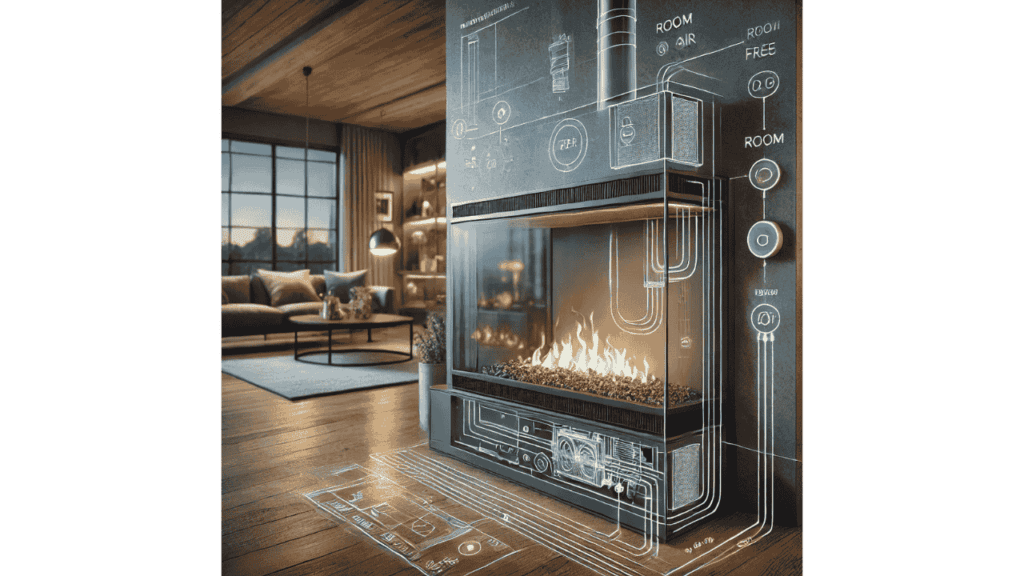Installing a gas fireplace without a chimney might sound challenging, but it’s quite achievable with the right approach. Many homeowners face the dilemma of wanting the warmth and ambiance of a gas fireplace but lack the existing infrastructure for a traditional chimney. This guide will walk you through how to properly vent your gas fireplace, exploring different methods that fit various home setups. We’ll cover everything from choosing the right venting option and installation, to ongoing maintenance. By the end, you’ll be well-equipped to enhance your home with a safe and efficient gas fireplace, even without a chimney. Let’s dive into how you can achieve this and what you need to consider for a successful setup.
Why Vent a Gas Fireplace?
Venting a gas fireplace is crucial for more than just maintaining the aesthetic appeal of your flame; it’s about ensuring your home remains safe and comfortable. Let me break down why proper ventilation is so important.
Ensuring Proper Air Circulation
Proper air circulation is essential for the efficient operation of your gas fireplace. It ensures that combustion gases are safely expelled outside, preventing harmful byproducts like carbon monoxide from lingering in your home. In my experience, a well-ventilated fireplace not only runs more efficiently but also maintains better air quality, keeping your living environment healthy.
Learn More: Function of Pilot Light on a Gas Fireplace
True History
The practice of venting gas fireplaces has evolved significantly over the years. Originally, all gas fireplaces required chimneys to ensure safe venting. However, advances in technology have introduced options that allow for safe venting without traditional chimneys. Understanding the development of these systems can help you appreciate the safety measures integrated into modern designs, ensuring that even without a chimney, your fireplace vents effectively and safely.
Considerations Before Venting a Gas Fireplace Without a Chimney
Before you proceed with venting your gas fireplace without a traditional chimney, there are several key factors to consider to ensure the project is successful and compliant.
Local Building Codes and Regulations
First and foremost, check your local building codes and regulations. Each area has its own set of rules governing the installation of venting systems for gas fireplaces. These regulations are designed to ensure safety and efficiency, so adhering to them is crucial. In my years of working with gas fireplaces, I’ve seen many projects go smoothly thanks to thorough compliance with local codes.
The Importance of Professional Consultation
It’s also vital to consult with a professional before starting any modifications to your fireplace. A certified technician can offer invaluable advice on the best venting methods for your specific setup and ensure that your installation meets all safety standards. From personal experience, I can say that professional insights can prevent costly mistakes and enhance the overall efficiency of your fireplace.
Step-by-Step Guide to Vent a Gas Fireplace Without a Chimney
Venting a gas fireplace without a traditional chimney can be straightforward if you follow these carefully structured steps. Let’s walk through the process to ensure you achieve a safe and efficient setup.
Choosing the Right Venting Method
The first step is to choose the appropriate venting method for your fireplace. Options include direct venting, which uses a dual pipe system that allows for air intake and exhaust, and vent-free systems, which are designed to operate without any external venting. Each method has its benefits and suitability depends on your home’s layout and local code requirements.
Gathering the Necessary Tools and Materials
Once you’ve selected the venting method, gather all the necessary tools and materials. You’ll likely need vent pipes, sealant, screws, and insulation, among other items. Having everything on hand before you start ensures a smoother installation process.
Selecting an Appropriate Location
Choosing the right location for your vent is crucial. It should be an exterior wall that allows for easy routing of vent pipes and minimal structural disruption. Ensure the selected spot also adheres to local building regulations regarding clearances from windows, doors, and other elements.
Installing Vent Pipes and Connections
With the location set, you can install the vent pipes. This involves drilling through the exterior wall, mounting the vent pipes securely, and ensuring all connections are tight and secure to prevent any leaks. Correct installation is vital for both safety and the efficient operation of your fireplace.
Sealing and Insulating the Venting System
Finally, properly seal and insulate the venting system. This step is crucial to prevent heat loss and protect against air ingress, which can affect the fireplace’s efficiency. Use high-quality sealants and insulation to wrap the vent pipes, ensuring they are well protected from the elements and temperature variations.
Read More: Changing Gas Fireplace to Electric
Maintenance and Safety Tips
To ensure your ventless gas fireplace operates safely and efficiently over the long term, regular maintenance is essential. Here’s what you need to keep in mind:
Regular Inspections and Cleaning
Schedule regular inspections and thorough cleanings of your gas fireplace system. This includes checking the venting components, if applicable, to ensure they are clear of blockages and in good repair. It’s also important to clean the fireplace unit itself to prevent build-up of dust and debris which can affect performance. These routine checks not only extend the life of your fireplace but also help maintain its safety and efficiency, giving you peace of mind and a warmer home.
Bottom Line
Venting a gas fireplace without a chimney is a viable option that can significantly enhance the comfort and safety of your home. By carefully selecting the right venting method, ensuring compliance with local codes, and engaging with professionals, you can achieve efficient heating without traditional chimney constraints. Regular maintenance further guarantees your system’s longevity and performance. Embrace these modern solutions to enjoy a cozy, safe, and warm environment in your living space.
- 27 Farmhouse Fireplace Ideas That Bring Warmth & Charm - August 18, 2025
- 25 Fireplace Lighting Ideas to Illuminate Your Hearth - August 7, 2025
- How to Replace an Electric Fireplace Switch? - August 5, 2025



